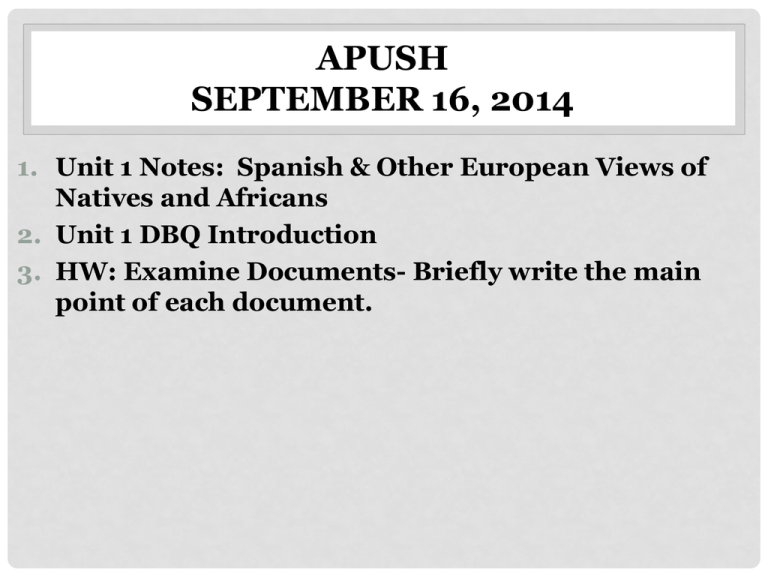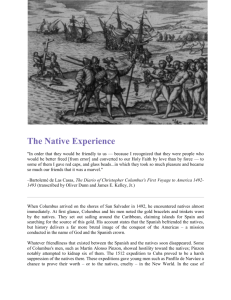File
advertisement

APUSH SEPTEMBER 16, 2014 1. Unit 1 Notes: Spanish & Other European Views of Natives and Africans 2. Unit 1 DBQ Introduction 3. HW: Examine Documents- Briefly write the main point of each document. Period 1: 1491 - 1607 UNIT 1 SPANISH VIEWS OF NATIVES AND AFRICANS SPANISH VIEWS OF NATIVES AND AFRICANS • Treaty of Tordesillas between Spain and Portugal ensured Spain’s claims in New World (Mexico, Peru, Spanish West Indies) • Spanish did not understand Natives and their cultures. • Natives were viewed as primitive illiterate savages by many Europeans. • Many Spaniards advocated harsh treatment of Natives and claimed slavery for Natives was justified throughout Catholic conversion. • Some Spaniards argued that Natives deserved the same treatment as all other men. • This belief played an instrumental role in the ending of the Encomienda system. • Replaced with Repartimiento System. • Over time most Europeans developed a belief in white superiority to justify the harsh treatment of Africans and Natives. • The promise of gold, other riches, and/or more labor prompted Spanish explores to venture north into modern day US (Southwest and Florida) VIEWS OF NATIVES AND AFRICANS • Spanish Catholic Conversion of Natives: • Mission System: • Outposts throughout the Americas to help convert Natives • Outposts were often military bases as well • Spanish defeated the Pueblos • Spanish established Santa Fe in 1610 • Spanish priests and government suppressed Native practices that were inconsistent with Christianity • Spanish demanded labor from Natives (Encomienda) AFRICAN SLAVERY • African slavery across the Atlantic began with early Spanish colonization of New World. • Spanish turned to Africa for cheap labor after Native populations were destroyed by disease or war. • Many Africans tried to preserve their culture in the New World • Many would combine elements of Christianity with their native African religions and customs. DBQ #1 • Using the documents and your own understanding of early American history, determine the initial impressions that the Europeans and non-Europeans created of the other, reaching some conclusions about how these initial impressions and attitudes might have influenced the ways each group chose to deal with each other in the New World.



